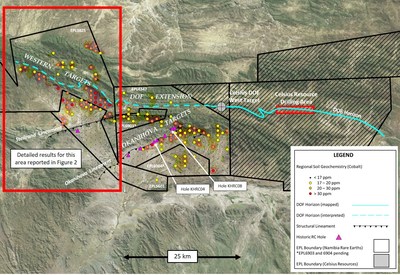- Detailed analyses of archived soil samples have confirmed
kilometer-scale cobalt anomalies in the Western Targets area at
Kunene
- Results pending over eastern DOF Extension and Okanihova
Target areas
- Field teams following up with geological mapping and rock
sampling
HALIFAX, March 5, 2018 /CNW/ - Namibia Rare Earths
Inc. ("Namibia Rare Earths" or the "Company") (TSXV: NRE) today
announced that it has received positive results from analyses of
archived soil samples over the Western Targets area on the Kunene
Cobalt-Copper Project in northern Namibia. These results confirm kilometer-scale
cobalt anomalies previously inferred from a historic regional
geochemical survey. Additional results are pending from targets
identified along the DOF Extension and the Okanihova Targets.

Namibia Rare Earths is conducting systematic exploration over an
area of 2,142 km2 west of the newly discovered
stratabound Co-Cu discovery of Celsius Resources at Opuwo (Figure
1). The Western Targets area is one of three principal cobalt
target areas at Kunene. The three target areas were defined on the
basis of soil geochemical surveys by previous workers exploring for
copper in 2014 at a regional-scale sample spacing of 1 kilometer
(Company press release February 21,
2018). Samples from those surveys were analysed by ICP,
which is an acceptable analytical method for cobalt. Subsequently,
more detailed sampling along selected lines at a spacing of 100
meters utilized handheld XRF data, which provided reliable data for
copper and other metals but was not reliable for cobalt. Namibia
Rare Earths is systematically re-analysing this archived database
of over 12,000 soil samples to obtain reliable data on cobalt.
Regional anomalies are being confirmed by repeat analyses of
archived samples using ICP analytical methods for cobalt (Figure
2). Sample preparation and analytical work was provided by
Activation Laboratories Ltd. (Windhoek,
Namibia and Ancaster,
Ontario) employing ICP techniques following strict internal
QAQC procedures inserting blanks, standards and duplicates.
In the Western Targets area these anomalies extend over strike
lengths of up to 7 kilometers in basement rocks (high grade
metamorphic gneisses and amphibolites) proximal to thrust contacts
with younger sedimentary rocks, and for over 1-3 kilometers in
favourable sedimentary horizons (black shales and dolostones).
Basement-related anomalies (20-50 ppm Co) can be quite broad, up to
2 kilometers wide, and are related to large-scale alteration
systems. Cobalt anomalies are lower level (20-30 ppm) in
sedimentary horizons and more restricted which is consistent with
the exploration model developed for the stratabound Dolostone Ore
Formation ("DOF") Co-Cu targets which may be only 5-10 meters in
thickness and occur in black shales and dolostone horizons.
Field teams are currently conducting geological mapping and rock
sampling over these anomalous areas.
The Kunene project area is contiguous with ground being actively
explored for cobalt by ASX-listed Celsius Resources (Figure 1). The
recognition of stratabound cobalt mineralization associated with
low grade copper and zinc mineralization in black shales in the
Kunene region by Gecko Exploration has formed the cornerstone of
Celsius Resources' current drilling program at Opuwo. Celsius is
undertaking a 15,000 meter drilling program to develop a JORC
compliant mineral resource to support their stated "Initial
Exploration Target of between 33 and 41 million tonnes, grading
approximately 0.13% - 0.17% cobalt and 0.45% - 0.65% copper"
(Celsius press release dated May 18,
2017). It is noted that the potential quantity and grade of
this Initial Exploration Target is conceptual in nature, and that
there has been insufficient exploration to estimate a Mineral
Resource, and it is uncertain if further exploration will result in
the estimation of a Mineral Resource.
Donald M. Burton, P.Geo. and
President of Namibia Rare Earths Inc., is the Company's Qualified
Person and has reviewed and approved this press release.
About Namibia Rare Earths Inc.
Namibia Rare Earths Inc. is focused on the accelerated
development of the Lofdal Rare Earths Project and on building a
critical metals portfolio in Namibia. The common shares of Namibia Rare
Earths Inc. trade on the TSX Venture Exchange under the symbol
"NRE".
Neither the TSX Venture Exchange nor its Regulation Services
Provider (as that term is defined in the policies of the TSX
Venture Exchange) accepts responsibility for the adequacy or
accuracy of this release.
The foregoing information may contain forward-looking
information relating to the future performance of Namibia Rare
Earths Inc. Forward-looking information, specifically, that
concerning future performance, is subject to certain risks and
uncertainties, and actual results may differ materially. These
risks and uncertainties are detailed from time to time in the
Company's filings with the appropriate securities commissions.
SOURCE Namibia Rare Earths Inc.